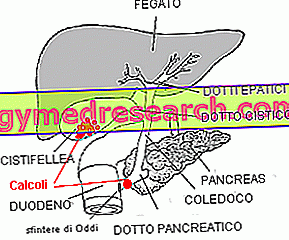BLOPRESS ® is a drug based on candesartan cilexetil.
THERAPEUTIC GROUP: Antihypertensives - angiotensin II receptor antagonists
IndicationsAction mechanismStudies and clinical effectiveness Usage and dosage instructionsWarnings Pregnancy and lactationInteractionsContraindicationsUndesirable effects

Indications BLOPRESS ® Candesartan cilexetil
BLOPRESS® is used in patients with essential hypertension, heart failure and altered left ventricular systolic function. In these latter conditions it can be used in case of intolerance to ACE inhibitors or, when tolerated, in synergy with these, in order to improve its therapeutic properties.
Mechanism of action BLOPRESS ® Candesartan cilexetil
BLOPRESS ® administered orally, is absorbed only to a small extent, ensuring bioavailability values that rarely exceed 14%, determining the beginning of therapeutic activity 2 hours later, and reaching the maximum plasma peak after a good 3.5 hours from his assumption. In order for BLOPRESS ® to exercise its therapeutic action, it is necessary that its active ingredient, candesartan cilexetil, be transformed into the active metabolite candesartan (through a hydrolysis that is rapidly achieved at the level of the gastro-enteric tract). Once absorbed and largely bound to plasma proteins, candesartan can thus reach the various target organs and perform its therapeutic action. The biological activity of this molecule materializes in the antagonistic action against angiotensin II on AT1 receptors. In fact, the angiotensin II-AT1 receptor binding determines a series of effects - such as vasoconstriction, aldosterone stimulation, induction of cell growth and regulation of hydro-saline homeostasis - which contribute, among other things, to supporting blood pressure. Candesartan, by binding the AT1 receptor in a fairly stable manner prevents its activation by angiotensin II, significantly reducing vascular contraction and ensuring a significant reduction in arterial pressure without reflex mechanisms potentially dangerous for the patient's health.
After the effect, after a half-life of about 9 hours, the active principle is largely eliminated via the urine and in a small part also via the bile.
Studies carried out and clinical efficacy
1 CANDESARTAN IN THE TREATMENT OF HYPERTENSION
In this study conducted on over 700 patients suffering from hypertension (blood pressure levels above 140/90 mmHg), and in some cases from diabetes, the administration of 8 mg of candesartan cilexetil for 4/6 weeks, guaranteed a reduction in blood pressure about 20 mmHg, bringing these patients back to a normal range of pressure
2. CANDESARTAN AND TREATMENT OF HYPERTENSION IN PATIENTS AT RISK OF INFARTO.
Treatment with candesartan during the acute phase of ischemia, although it does not determine an immediate hypotensive action, guarantees in the short term (more precisely in only 14 days of therapy), a decrease in blood pressure of about 25 mmHg, reducing the risk future of acute ischemic stroke.
3. CANDESARTAN, THE MOST EFFECTIVE SARTAN
A careful rereading of the international scientific documentation has shown how candesartan is among the angiotensin II receptor antagonists, one of those with greater affinity and with greater therapeutic effect. Among the various advantages derived from the administration of this drug, it is possible to include the particular antihypertensive efficacy in association with diuretics or other antihypertensives, against a series of side effects of modest clinical entity.
Method of use and dosage
BLOPRESS ® Candesartan cilexetil 8/16/32 mg tablets: the doses prescribed for the treatment of hypertension normally include doses of between 8 and 16 mg per day (1/2 tablets per day). In cases where the patient is found to be refractory to this dosage, he could reach a maximum of 32 mg / day, or choose an alternative antihypertensive therapy.
In the treatment of heart failure, on the other hand, doses of 4 mg of candesartan cinexidil are suggested.
Therapeutic efficacy is generally observed for prolonged administration for at least 4 weeks.
An adjustment of the dosage must be carried out in some categories of patients at risk, for which the doctor must carefully evaluate the physio-pathological conditions, and choose a dose that can minimize the possible side effects, while preserving the therapeutic functions.
Warnings BLOPRESS ® Candesartan cilexetil
CONFLOPRESS ® therapy, especially in patients with heart failure, could lead to a significant reduction in renal function; therefore, plasma levels of potassium and creatinine should be constantly monitored.
It is necessary to consider that the concomitant administration of drugs capable of interfering with the renin-angiotensin system, or various types of antihypertensives, could lead to even hypotensive episodes. Particular attention must be paid in case of simultaneous administration of potassium-sparing diuretics, due to the risk of hyperkalaemia and consequent alteration of the normal heart rhythm.
Stroke and heart attack may be more frequent in patients with ischemic heart disease or cardiovascular ischemic disease, due to the high hypotensive effect of the drug.
The presence of lactose could cause a series of side effects in patients who are intolerant to galactose, lactose or lactase deficiency and glucose and / or galactose malabsorption.
Despite the absence of a direct correlation between the administration of BLOPRESS ® reduction of the patient's perceptive and reactive potential, any hypotensive episodes or side effects of various kinds could compromise the ability to drive and use machinery.
PREGNANCY AND BREASTFEEDING
We strongly advise against the use of BLOPRESS ® during pregnancy, as candesartan could cause an alteration of the fetal blood perfusion, seriously compromising its growth and development. Preclinical studies conducted in animals, on the other hand, showed a causal link between the intake of BLOPRESS ® fetal and neonatal malformations.
During lactation, although not yet ascertained on human milk, the active ingredient of BLOPRESS ® could be secreted in breast milk; therefore, we do not recommend taking it during this period.
Interactions
The number of studies evaluating the simultaneous administration of BLOPRESS ® of other drugs appears to be limited; however it is possible to describe some combinations that alter the normal functionality of the candesartan. More precisely, the simultaneous intake of other drugs with antihypertensive activity, or capable of affecting the renin-angiontensin system, could determine an increase in the hypotensive effect with consequent risk for the patient's health.
Potassium-sparing diuretics, or supplements of this trace element, could increase the risk of hyperkalemia. Non-steroidal anti-inflammatory drugs could counteract the antihypertensive action of BLOPRESS ®
Contraindications BLOPRESS ® Candesartan cilexetil
The use of BLOPRESS ® during pregnancy and lactation is not recommended, in the case of cholestasis, severe liver failure or hypersensitivity to one of its components.
Undesirable effects - Side effects
The undesirable effects of BLOPRESS ® are in most cases mild and transient, with involvement of the central nervous system (headache and dizziness), cardiovascular (hypotension), urinary (altered renal function) and blood (altered plasma levels of transaminase, creatinine, potassium and urea).
However, in only a few cases was it necessary to suspend therapy.
In case of hypersensitivity to one of the components of BLOPRESS ®, dermatological (eruptions, rush) and febrile reactions have been observed.
Note
BLOPRESS ® is salable only under medical prescription



